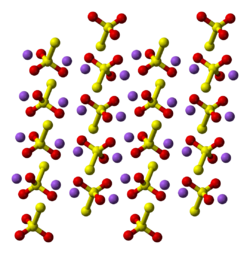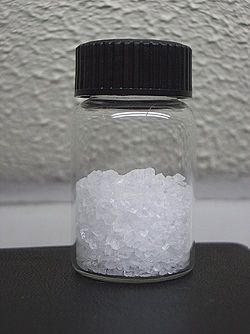- Sodium thiosulfate
-
Sodium thiosulfate 

 Sodium thiosulfateOther namesSodium hyposulfite
Sodium thiosulfateOther namesSodium hyposulfite
Hyposulphite of sodaIdentifiers CAS number 7772-98-7  ,
,
10102-17-7 (pentahydrate)PubChem 24477 ChemSpider 22885 
UNII L0IYT1O31N 
ChEMBL CHEMBL1201157 
RTECS number XN6476000 Jmol-3D images Image 1 - [Na+].[Na+].[O-]S([O-])(=O)=S
Properties Molecular formula Na2S2O3 Molar mass 158.11 g/mol Appearance white crystals Odor odorless Density 1.667 g/cm3 Melting point 48.3 °C (pentahydrate)
Boiling point 100 °C (pentahydrate, - 5H2O decomp)
Solubility in water 76.4 g/100 g H20(20 °C) Hazards MSDS External MSDS EU Index Not listed NFPA 704 Flash point Non-flammable  (verify) (what is:
(verify) (what is:  /
/ ?)
?)
Except where noted otherwise, data are given for materials in their standard state (at 25 °C, 100 kPa)Infobox references Sodium thiosulfate (Na2S2O3), also spelled sodium thiosulphate, is a colorless crystalline compound that is more familiar as the pentahydrate, Na2S2O3•5H2O, an efflorescent, monoclinic crystalline substance also called sodium hyposulfite or “hypo.”
The thiosulfate anion is tetrahedral in shape and is notionally derived by replacing one of the oxygen atoms by a sulfur atom in a sulfate anion. The S-S distance indicates a single bond, implying that the sulfur bears significant negative charge and the S-O interactions have more double bond character. The first protonation of thiosulfate occurs at sulfur.
Contents
Industrial production and laboratory synthesis
On an industrial scale, sodium thiosulfate is produced chiefly from liquid waste products of sodium sulfide or sulfur dye manufacture.[1] In the laboratory, this salt can be prepared by heating an aqueous solution of sodium sulfite with sulfur.
Principal reactions and applications
Thiosulfate anion characteristically reacts with dilute acids to produce sulfur, sulfur dioxide and water:[1]
- Na2S2O3 + 2HCl → 2NaCl + S + SO2 + H2O
This reaction is known as a "clock reaction", because when the sulfur reaches a certain concentration the solution turns from colourless to a pale yellow. This reaction has been employed to generate colloidal sulfur. When the protonation is conducted at low temperatures, H2S2O3 (thiosulfuric acid) can be obtained. It is a somewhat strong acid with pKas of 0.6 and 1.7 for the first and second dissociation respectively.
Iodometry
In analytical chemistry, the most important use comes from the fact that the thiosulfate anion reacts stoichiometrically with iodine, reducing it to iodide as it is oxidized to tetrathionate:
- 2 S2O32−(aq) + I2(aq) → S4O62−(aq) + 2 I−(aq)
Due to the quantitative nature of this reaction, as well as the fact that Na2S2O3•5H2O has an excellent shelf-life, it is used as a titrant in iodometry. Na2S2O3•5H2O is also a component of iodine clock experiments.
This particular use can be set up to measure the oxygen content of water through a long series of reactions. It is also used in estimating volumetrically the concentrations of certain compounds in solution (hydrogen peroxide, for instance) and in estimating the chlorine content in commercial bleaching powder and water.
Photographic processing
The terminal sulfur atom in S2O32− binds to soft metals with high affinity. Thus, silver halides, e.g. AgBr, typical components of photographic emulsions, dissolve upon treatment with aqueous thiosulfate:
- 2 S2O32− + AgBr → [Ag(S2O3)2]3− + Br−
In this application to photographic processing, discovered by John Herschel and used for both film and photographic paper processing, the sodium thiosulfate is known as a photographic fixer, and is often referred to as hypo, from the original chemical name, hyposulphite of soda.[2]
Gold extraction
Sodium thiosulfate is one component of an alternative lixiviant to cyanide for extraction of gold.[3] It forms a strong complex with gold(I) ions, [Au(S2O3)2]3−. The advantage of this approach is that thiosulfate is essentially non-toxic and that ore types that are refractory to gold cyanidation (e.g. carbonaceous or Carlin type ores) can be leached by thiosulfate. Some problems with this alternative process include the high consumption of thiosulfate, and the lack of a suitable recovery technique, since [Au(S2O3)2]3− does not adsorb to activated carbon, which is the standard technique used in gold cyanidation to separate the gold complex from the ore slurry.
Analytical chemistry
Sodium thiosulfate is also used in analytical chemistry. It can, when heated with a sample containing aluminum cation, produce a white precipitation:
- 2 Al3+ + 3 S2O32− + 3 H2O → 3 SO2 + 3 S + 2 Al(OH)3
Medical
- It is used as an antidote to cyanide poisoning.[4][5] Thiosulfate acts as a sulfur donor for the conversion of cyanide to thiocyanate (which can then be safely excreted in the urine), catalyzed by the enzyme rhodanase.
- It has also been used as treatment of calciphylaxis in hemodialysis patients with end-stage renal disease.[6]
- It is used in the management of extravasations during chemotherapy. Sodium thiosulfate prevents alkylation and tissue destruction by providing a substrate for the alkylating agents that have invaded the subcutaneous tissues. The dose may be 2mL of 0.17M (a solution of 4mL 10% sodium thiosulfate and 6mL sterile water for injection). It may be instilled subcutaneously into multiple sites using a small gauge needle. There is limited data on this method with few recommendations.[citation needed]
- in foot baths for prophylaxis of ringworm, and as a topical antifungal agent for tinea versicolor.
- in measuring the volume of extracellular body fluid and the renal glomerular filtration rate. [7]
Other uses
Sodium thiosulfate is also used:
- As a component in hand warmers and other chemical heating pads that produce heat by exothermic crystallization of a supercooled solution.
- In bleach
- In pH testing of bleach substances. The universal indicator and any other liquid pH indicators are destroyed by bleach, rendering them useless for testing the pH. If one first adds sodium thiosulfate to such solutions, it will neutralize the color-removing effects of bleach and allow one to test the pH of bleach solutions with liquid indicators. The relevant reaction is akin to the iodine reaction: thiosulfate reduces the hypochlorite (active ingredient in bleach) and in so doing becomes oxidized to sulfate. The complete reaction is:
- 4 NaClO + Na2S2O3 + 2 NaOH → 4 NaCl + 2 Na2SO4 + H2O
- To dechlorinate tap water for aquariums or treat effluent from waste water treatments prior to release into rivers. The reduction reaction is analogous to the iodine reduction reaction. Treatment of tap water requires between 0.1 grams and 0.3 grams of pentahydrated (crystalline) sodium thiosulfate per 10 liters of water.
- To lower chlorine levels in swimming pools and spas following super chlorination.
- To remove iodine stains, e.g. after the explosion of nitrogen triiodide.
- Similarly, sodium thiosulfate reacts with bromine to render harmless products. Solutions of sodium thiosulfate are commonly used as a precaution in chemistry laboratories when working with bromine.
- In bacteriological water assessment.
- In the tanning of leather.
- To demonstrate the concept of reaction rate in chemistry classes. The thiosulfate ion can decompose into the sulfite ion and a colloidal suspension of sulfur, which is opaque. The equation for this acid-catalysed reaction is as follows:
S2O32−(aq) → SO32−(aq) + S(s) - To demonstrate the concept of supercooling in physics classes. Melted sodium thiosulfate is very easy to overcool to room temperature and when crystallization is forced, the sudden temperature jump to 48.3°C can be experienced by touch.
- As part of patina recipes for copper alloys.
- Often used in pharmaceutical preparations as an anionic surfactant to aid in dispersion.
- It can also be used as a very interesting solute in supersaturation experiments.
References
- ^ a b Holleman, A. F.; Wiberg, E. "Inorganic Chemistry" Academic Press: San Diego, 2001. ISBN 0-12-352651-5
- ^ Charles Robert Gibson (1908). The Romance of Modern Photography, Its Discovery & Its Achievements. Seeley & Co. p. 37. http://books.google.com/?id=whYaAAAAMAAJ&pg=PA37&dq=hyposulphite-of-soda+herschel+fixer+hypo.
- ^ Aylmore, M. G.; Muir, D. M. "Thiosulfate Leaching of Gold - a Review", Minerals Engineering, 2001, 14, 135-174
- ^ "Toxicity, Cyanide: Overview - eMedicine". http://emedicine.medscape.com/article/814287-overview. Retrieved 2009-01-01.
- ^ Hall AH, Dart R, Bogdan G (June 2007). "Sodium thiosulfate or hydroxocobalamin for the empiric treatment of cyanide poisoning?". Ann Emerg Med 49 (6): 806–13. doi:10.1016/j.annemergmed.2006.09.021. PMID 17098327.
- ^ Cicone JS, Petronis JB, Embert CD, Spector DA (June 2004). "Successful treatment of calciphylaxis with intravenous sodium thiosulfate". Am. J. Kidney Dis. 43 (6): 1104–8. doi:10.1053/j.ajkd.2004.03.018. PMID 15168392.
- ^ "Sodium thiosulfate" at Dorland's Medical Dictionary
Sodium compounds NaAlO2 · NaBH3(CN) · NaBH4 · NaBr · NaBrO3 · NaCH3COO · NaCN · NaC6H5CO2 · NaC6H4(OH)CO2 · NaCl · NaClO · NaClO2 · NaClO3 · NaClO4 · NaF · NaH · NaHCO3 · NaHSO3 · NaHSO4 · NaI · NaIO3 · NaIO4 · NaMnO4 · NaNH2 · NaNO2 · NaNO3 · NaN3 · NaOH · NaO2 · NaPO2H2 · NaReO4 · NaSCN · NaSH · NaTcO4 · NaVO3 · Na2CO3 · Na2C2O4 · Na2CrO4 · Na2Cr2O7 · Na2MnO4 · Na2MoO4 · Na2O · Na2O2 · Na2O(UO3)2 · Na2S · Na2SO3 · Na2SO4 · Na2S2O3 · Na2S2O4 · Na2S2O5 · Na2S2O6 · Na2S2O7 · Na2S2O8 · Na2Se · Na2SeO3 · Na2SeO4 · Na2SiO3 · Na2Te · Na2TeO3 · Na2Ti3O7 · Na2U2O7 · NaWO4 · Na2Zn(OH)4 · Na3N · Na3P · Na3VO4 · Na4Fe(CN)6 · Na5P3O10 · NaBiO3
Antidotes (V03AB) Nervous system Barbiturate overdoseBemegride • EthamivanBenzodiazepine overdoseGHB overdoseReversal of neuromuscular blockadeCardiovascular Other Paracetamol toxicity (Acetaminophen)nitrite (Amyl nitrite, Sodium nitrite#) • Sodium thiosulfate# • 4-Dimethylaminophenol • HydroxocobalaminOtherPrednisolone/promethazine • oxidizing agent (potassium permanganate) • iodine-131 (Potassium iodide) • Methylthioninium chloride#Emetic Ipecacuanha (Syrup of ipecac) • Copper sulfate#WHO-EM. ‡Withdrawn from market. Clinical trials: †Phase III. §Never to phase III Categories:- Thiosulfates
- Sodium compounds
- Photographic chemicals
- Antidotes
- World Health Organization essential medicines
Wikimedia Foundation. 2010.

